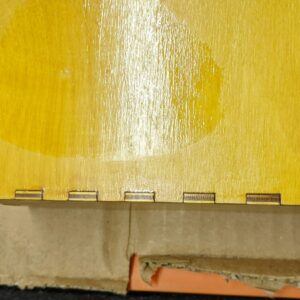Am I removing too much shellac with sanding or steel wool?
I’m working with shellac for the first time, and I’m not quite sure when to call it done. I’ve applied a few layers with different techniques (brushing, padding, sometimes cursing!) occasionally sanding in between.
Is there a point where I remove too much, and the piece becomes “less shellacked” and I’ve somehow weakened or ruined the finish? For example, after any layer I was never able to get an even finish, so there were always some “heavy” areas compared to some lighter ones. The only way I was ever able to get a consistent look was with some 0000 steel wool, which took away the shine. While I initially was unhappy with the loss of the glossy look, the matte appearance is growing on me and am thinking of sticking with it.
Since shellac goes on pretty thin, is rubbing/buffing away the gloss somehow detrimental? It kind of feels like I’m applying the stuff, only to remove it all over again.
I’ve attached a photo with a “shiny” spot I applied yesterday to try and patch up an area. Is that spot “better” or “worse” than the area around it (buffed with steel wool)? Or is it all basically the same, and just down to my personal preference (i.e once I like the look, just call it done)?
The shellac I’m using is Zinsser Bulls Eye Amber, if that makes a difference.
















Replies
Whenever you sand or steel wool, you are indeed removing some of what you just applied. If you stained or dyed the wood, there is danger of removing some of the color, and the end result will be a disaster.
I always use 2 or three coats before any sanding or steel wooling. The purpose of that is to level the finish -- it serves no other purpose. Sanding should make a fine dust. If it doesn't, it's not dry enough.
I always use 0000 steel wool at the end. If I want a glossier look, I'll use some Renaissance wax after the steel wool.
If I need a sturdier finish than the shellac, I'll put a coat or two of water-based poly on top. But you can't do that on top of wax, and that Zinsser Amber has wax in it. Use Zinsser Sealcoat. It is dewaxed, and is the only premixed shellac I'll use.
I've used everything from sprayers to pads to apply shellac. 99 percent of the time a use a 1-1/2 inch brush for shellac. I find it applies much more evenly than a pad.
That amber is also very thick from the can. Cutting it 50% with alcohol before applying will give a more even coat.
Shellac is my go to finish and I use it a lot (both Zinser and flakes I dissolve). Well stated by john_c2 and my thoughts as well.
Thanks so much, that really helps! There's no other color on the project except for the amber from shellac, so I think I'll just get it to where I like the look and then call it.
I don't think I'll need a sturdier finish--it's a custom box to hold a board game, so it shouldn't see much wear and tear. For the Zinsser Sealcoat, does that stuff have the same "rules" as other shellac, in terms of application, drying, recoating? I just watched this video:
https://youtu.be/vt3WtAxmfzM?t=152
He just kind of slathered it on and immediately wiped it off with a paper towel--based on my experiences with the amber stuff, that would create a sticky mess!
Wipe off shellac? Noooo. That's for oil finishes.
Alcohol dissolves shellac. Put dry flakes in alcohol,the flakes dissolve, and you have shellac. Add more shellac, and it's thin shellac. Add a coat to dry shellac, and it melts the layer underneath, and you have a thicker single coat -- no layers. That's the beauty.
On the bad side, spill some booze on it, and it will melt the shellac on your tabletop.
I didn't have time to watch the videoso can't comment. But Sealcoat is just shellac with the wax removed. It also has a longer shelf life than other shellac.
This forum post is now archived. Commenting has been disabled